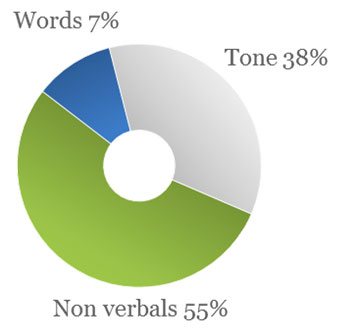Training South West Blog
What is the Meaning behind our Body Language?
 In the workplace, it is often challenging to communicate effectively and to avoid misunderstandings. Unconsciously, we interpret each other’s ‘social signals’ whilst speaking in order to interpret what somebody is saying. As a matter of fact, these non-verbal ways of communicating, influence our communication to a greater extent than anything we say.
In the workplace, it is often challenging to communicate effectively and to avoid misunderstandings. Unconsciously, we interpret each other’s ‘social signals’ whilst speaking in order to interpret what somebody is saying. As a matter of fact, these non-verbal ways of communicating, influence our communication to a greater extent than anything we say.
In fact, more than half of our communication depends on how we say things, rather than what we say.
Did you know that we process body language cues faster than we process language?
Our body language shapes our relationships with colleagues, managers, subordinates, and clients. It doesn't stop at the workplace however as our body language extends to all our transactions; whether it's an exchange whilst out shopping, communicating with our children or navigating directions.
So what do we mean when we talk about body language? Essentially, we're referring to features such as tone of voice, gestures, facial expressions, micro-expressions, posture, appearance, and eye contact.
The reaction to your words changes accordingly to the ‘social signals’, transmitted as you speak. The receiver of your message will either interpret it positively or negatively. This forms the basis for any (business) relationship, which influences all future encounters. For this reason, it's crucial to be aware of the huge influence of non-verbal communication and to use it as a tool to boost your interactions.
Understanding your social signals and using them to your advantage maximises your outputs in areas such as negotiations, team meetings, when delivering presentations or influencing ideas. By harnessing these signals, you are more likely to be successful and avoid pitfalls.
Let's look at some practical tips to help you manage this successfully.
Some practical body language tips for the workplace:
-Avoid leaning back when speaking to people as this can suggest that you're bored or disinterested in the conversation. To demonstrate real engagement, then consider leaning forward slightly.
-Crossing your arms is another no-no. Why? Because it suggests that you're creating barriers, lacking confidence, or resistant to the conversation.
-Use your posture to project confidence by keeping a relaxed pose, with your hands visible and your shoulders back. Slumping or fiddling with your hands suggests nerves, a lack of confidence, and even that you might have something to hide.
-Try to be empathetic to and to see the situation from the other person’s perspective.
-Show positive engagement in what you are being told by nodding or smiling to affirm agreement and interest. Every so often, consider summarising what they have told you to show that you are taking everything in.
-If you find the person you are speaking to mirroring your actions, then this is a good thing as it suggests that they empathise with what you are saying. You might want to subtly mirror a few of their actions too to signal the same cues. Be careful to avoid this looking orchestrated, however.
-Be aware of your own body language and non-verbal signals especially whilst speaking or giving presentations. It's good practice to ask your colleagues for feedback whenever possible so that you can assess how you are perceived by others and make changes where necessary.
-If you feel like someone did not communicate according to your standards of ‘good communication’, focus on the message and what has been said instead of how it came across. If this is a one-off exchange, then avoid becoming reactive or showing offense as this individual may simply lack the skills needed to communicate effectively. If however, this individual is someone you need to communicate with regularly, and if they speak to you in a way that upsets or offends you, then speak to them privately and tell them how their way of communicating with you makes you feel. Avoid blame and try to position your feedback so that you are clear about what is irritating you and why.
Communication Skills Training
Our Body Language Training course is one of our most popular business training courses. Focusing on key areas such as non verbal cues, micro-facial expressions, gestures and mirroring, we help learners use body language as a critical tool to drive positive interactions.
This area is also covered in our more generic Communication Skills Training courses.
If you're a South West business, then contact us to discuss our communication skills training. Delivering to businesses across the South West, our qualified, expert communication trainers conduct training onsite across both large cities, such as Poole, Bournemouth, Exeter and Bristol, and more remote areas, such as Bridport, Sherborne, Liskeard and Axemouth.
Contact us to discuss training in Dorset, Somerset, Devon and Cornwall.

